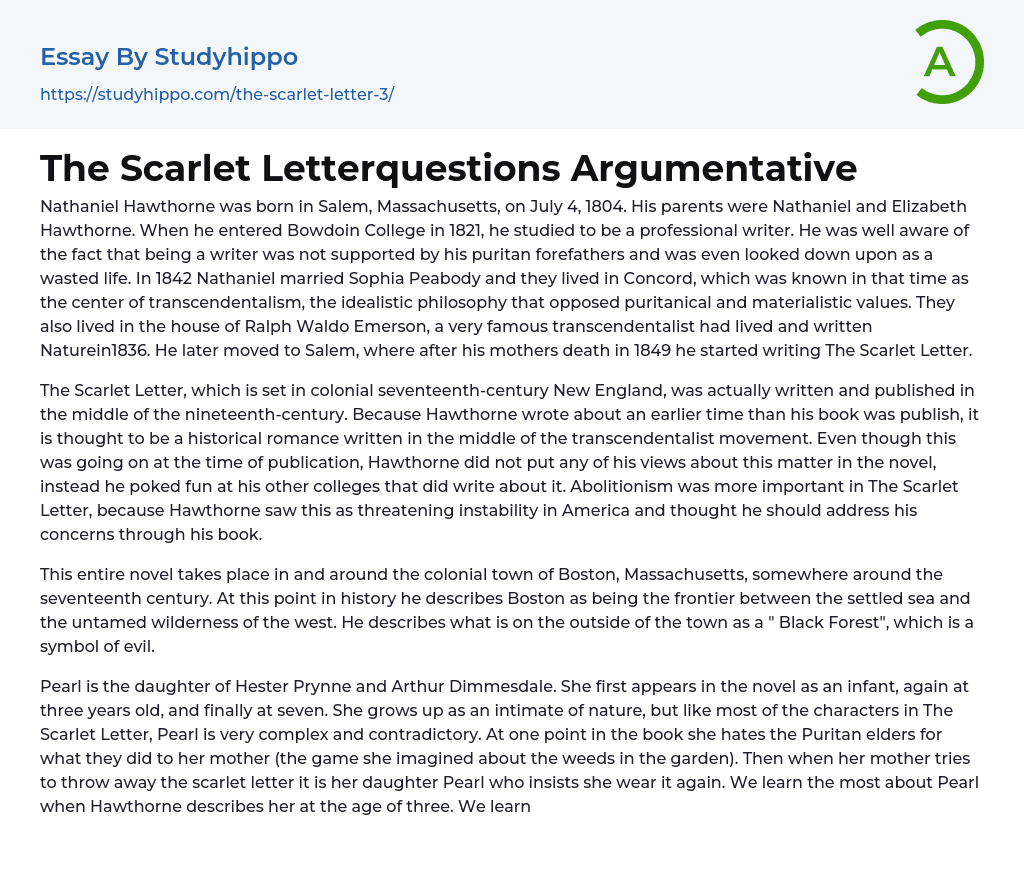Nathaniel Hawthorne was born in Salem, Massachusetts, on July 4, 1804. His parents were Nathaniel and Elizabeth Hawthorne. When he entered Bowdoin College in 1821, he studied to be a professional writer. He was well aware of the fact that being a writer was not supported by his puritan forefathers and was even looked down upon as a wasted life. In 1842 Nathaniel married Sophia Peabody and they lived in Concord, which was known in that time as the center of transcendentalism, the idealistic philosophy that opposed puritanical and materialistic values. They also lived in the house of Ralph Waldo Emerson, a very famous transcendentalist had lived and written Naturein1836. He later moved to Salem, where after his mothers death in 1849 he started writing The Scarlet Letter.
The Scarlet Letter, which is set in colonial seventeenth-century New
...England, was actually written and published in the middle of the nineteenth-century. Because Hawthorne wrote about an earlier time than his book was publish, it is thought to be a historical romance written in the middle of the transcendentalist movement. Even though this was going on at the time of publication, Hawthorne did not put any of his views about this matter in the novel, instead he poked fun at his other colleges that did write about it. Abolitionism was more important in The Scarlet Letter, because Hawthorne saw this as threatening instability in America and thought he should address his concerns through his book.
This entire novel takes place in and around the colonial town of Boston, Massachusetts, somewhere around the seventeenth century. At this point in history he describes Boston as being the frontier between the settled
sea and the untamed wilderness of the west. He describes what is on the outside of the town as a " Black Forest", which is a symbol of evil.
Pearl is the daughter of Hester Prynne and Arthur Dimmesdale. She first appears in the novel as an infant, again at three years old, and finally at seven. She grows up as an intimate of nature, but like most of the characters in The Scarlet Letter, Pearl is very complex and contradictory. At one point in the book she hates the Puritan elders for what they did to her mother (the game she imagined about the weeds in the garden). Then when her mother tries to throw away the scarlet letter it is her daughter Pearl who insists she wear it again. We learn the most about Pearl when Hawthorne describes her at the age of three. We learned that her beauty was radiant and glowing, and that her hair was a shiny brown. Throughout the novel we see that she is puzzling, with strong mood swings and a fierce temper. Her behavior is so unusual that the Puritans believe she is a "demon child." Although Pearl is thought by most readers to be a very strange character, she is really the strongest symbol in the novel, standing for many things. She is an obvious symbol of Hester's sin of adultery. While standing on the scaffold in front of the townspeople Hester realizes that her baby is a symbol when she thinks of covering the scarlet letter with her baby. Also when the baby starts having pains, in chapter 4, she becomes a symbol of the pain
Hester has suffered on her day of punishment. Pearl's ability to show emotion helped Hawthorne to make her a very vivid symbol throughout the entire novel. The older Pearl gets the more her actions and questions bother her mother. Pearl hates everything the scarlet letter on her mother's breast represents, so every time she sees it she tries to destroy it, which causes her mother great pain. Pearl is also a symbol of her father Dimmesdale's living conscience. She is a reminder of what Dimmesdale must do in order to save his soul.
The Scarlet Letter starts as the narrator describes a prison door. After this elaborate description the door opens to show a woman, Hester Prynne, with a baby and an "A" embroidered on her breast. She is being punished for the crime of adultery. While serving her punishment, which was to stand on a scaffold before the townspeople,
- Aldous Huxley essays
- Alice Walker essays
- Amy tan essays
- Anne Bradstreet essays
- Anton Chekhov essays
- Arthur Miller essays
- Augustine essays
- Bertolt Brecht essays
- Booker T Washington essays
- Carol ann duffy essays
- Charles Dickens essays
- Charlotte Perkins Gilman essays
- Chinua Achebe essays
- Christina Rossetti essays
- Consider The Lobster essays
- Edgar Allan Poe essays
- Elizabeth Bishop essays
- Emily Dickinson essays
- Ernest Hemingway essays
- F. Scott Fitzgerald essays
- George Orwell essays
- Harper Lee essays
- Homer essays
- James Baldwin essays
- Jane Austen essays
- John Donne essays
- John Steinbeck essays
- Kate Chopin essays
- Kurt Vonnegut essays
- Langston Hughes essays
- Leonardo Da Vinci essays
- Mark Twain essays
- Mary Shelley essays
- Maya Angelou essays
- Nathaniel Hawthorne essays
- Oscar Wilde essays
- Percy Bysshe Shelley essays
- Peter Skrzynecki essays
- Phillis Wheatley essays
- Poets essays
- Ralph Waldo Emerson essays
- Ray Bradbury essays
- Richard Rodriguez essays
- Robert Browning essays
- Robert Frost essays
- Robert Louis Stevenson essays
- Seamus Heaney essays
- Sherman Alexie essays
- Sophocles essays
- Stephen King essays




